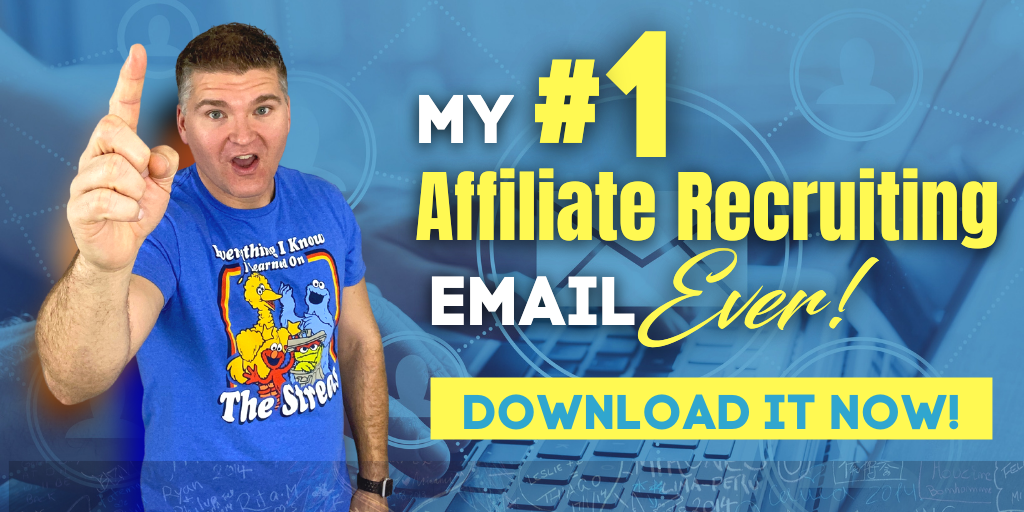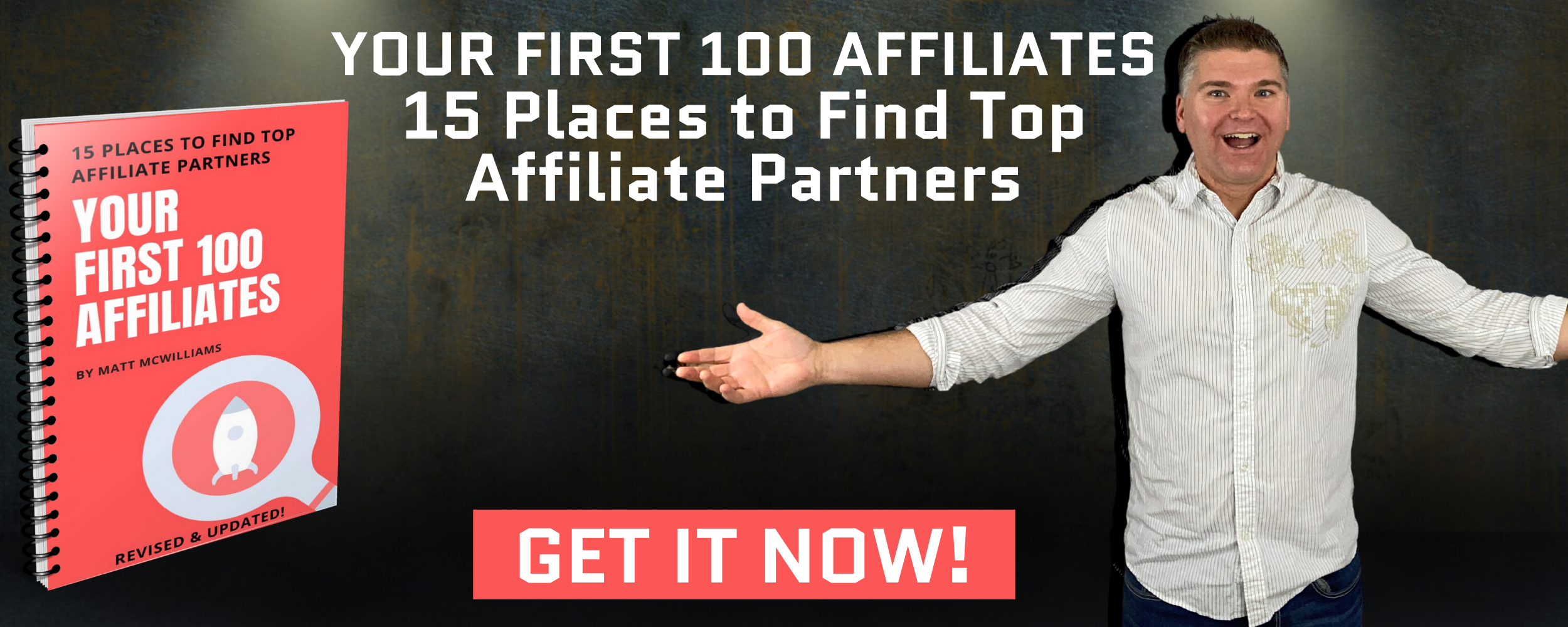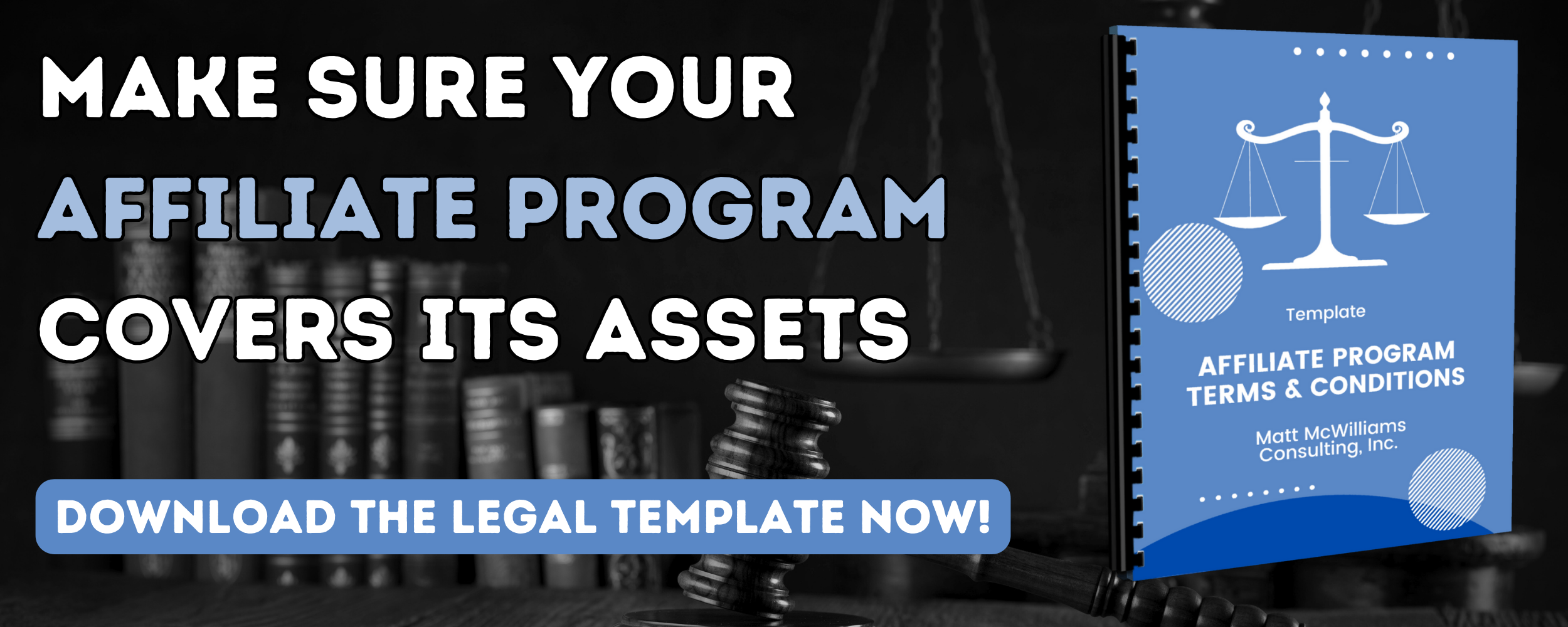Too many people make affiliate marketing out to be too complicated. They say it’s part science that requires decades of learning and experience and part “dark art” that requires the touch of a wizard to master. But neither of these are true. In fact, affiliate marketing is easier than you think. Today, I’ll share why…and how to tap into the proven path to success in affiliate marketing.
Click Here for The Written Transcript of This Episode
Get my #1 affiliate recruiting email (the one I’ve personally used to recruit thousands of affiliates in dozens of niches). Grab your copy here!
LINKS MENTIONED IN THIS EPISODE
Text me at 260-217-4619
Don’t Miss An Episode – Subscribe Below
Previous Episodes of The Affiliate Guy
How to Negotiate Affiliate Deals That Benefit Everyone
How to Build Your Personal Brand and Become a Celebrity in Your Niche with Rory Vaden
Why Your Affiliate Program is Failing (And What to Do About It)
How to Build Strong Relationships with Your Affiliates
Why Affiliate Marketing Is Easier Than You Think
People make affiliate marketing out to be so complicated. Like, it’s part science that requires decades of experience in learning, part dark art that requires the touch of a wizard to master. But neither of these are true.
In fact, affiliate marketing is easier than you think. Today, I’ll share why and how to tap into the proven path to success in affiliate marketing. Welcome to the affiliate guide podcast.
If you want to grow your income, serve your tribe, and enjoy all the benefits of affiliate marketing and having your own affiliates, you’re in the right place. Thanks for joining me today. Let’s get started.
So if you’re here today thinking there’s some sort of success secret to promoting affiliate offers, there isn’t. There’s no secret formula, there’s no secret sauce, but there is a proven path that works every time. If you follow this path, you will be successful in your promotions.
And the thing about this quote unquote success path is that it actually applies to anything in life. This is what I found. Once you learn this path, you’ll see how it’s true everywhere.
It’s true with your own products, it’s true just in literally every aspect of life. It’s kind of cool. Now there’s five phases.
I originally figured this out from I kind of took what I had found in affiliate marketing. And then I actually was talking with Tom Ziggler. May or may not know this, but years ago I worked with Zig Ziggler’s Company after he passed away.
And I was at lunch with Tom, and I remember this Mexican restaurant in Franklin, Tennessee, and we were talking about this concept that he had, this sequence of success is what he called it. And I was like, oh my gosh, that applies to literally everything. Like we could apply that to our affiliate program that we’re doing with you.
And so we talked about that and we talked about how this works in every aspect of life. And it has five phases. Each one must come after the previous phase.
I mean, this is a path, right? You have to take step one, step two, step three. If you try to skip to phase five, you’re going to fail.
Even skipping phases two through four. Like, you can’t go from one to two and then go to five. You have to follow each of the phases.
So this is what I got from Tom, and again, it applies to every aspect of life here. And it starts with the first phase, which is belief. So again, there’s five phases of success in affiliate promotions, and the first one is belief.
I mentioned earlier, this path is true of any area of your life, not just affiliate promotions. Everything in life begins with belief. The default for far too many people today, when they purchase something or they try a product out, it’s not going to work for me.
They literally press the buy button and say to themselves, this won’t work for me. That sounds crazy when you think about it, but we’ve all done it. We assume like, it works for other people, but it doesn’t work for me.
That it works for some sort of special person, but not for me. The seller is hyping up his claims. We spend money, but we set ourselves up for failure.
And the key with anything that you’re promoting is to believe that it will work. Believe that your audience will benefit from using the product. One of the biggest reasons why people suck at selling is because they don’t believe in what they’re promoting.
I sucked at selling for years. When I first got into sales, gosh, over two decades ago. It’s hard to believe I sucked at sales because I was selling scared.
That is the number one reason why most people suck at selling. They sell scared. I’ve talked about this before.
They sell scared. What are they scared of? What are you scared of selling?
Are you scared of being rejected? Or scared of looking ridiculous? Scared of losing subscribers?
Scared of someone not liking you? Scared of a little two letter word that begins with N and ends with O? Like, we’re scared, right?
So when you sell scared, people instinctively know it just like a dog can sense fear. Your prospective customers, they know when you are selling scared. They can sense it.
It comes through in person. It comes through on the phone. It even comes through an email.
I shared this, I don’t know, 200 episodes ago. It was forever ago. It feels like how when you’re writing an email, the words you choose, it just comes across even in that email.
Like, we get it in person, right? The way that you look at people, or fail to, because you’re looking down. It comes across in your posture, your voice, your intonation.
But yeah, it even comes across in the words you choose an email. And so in a metaphorical sense, even in a literal sense, really, you’re transferring your fears to potential customers. No one wants that.
Zig Ziggler said that selling, and I’m going to butcher this quote, but selling is essentially a transference of feelings. If you are confident that it’s going to work, if you believe it’s going to work, that is transferred to the potential customer. So is that fear?
So when you sell scared, it feels weak, it feels slimy, it feels scary. No one wants to buy from someone who’s afraid to sell. No one wants to buy from someone who is afraid to sell.
Let me repeat that. No one wants to buy from someone who is afraid to sell. You have to understand that promoting affiliate offers is actually serving your audience.
We’ve talked about that in past episodes. So only promote things you have a good feeling about. Promote things that are proven to work for others.
They’ve proven to work for you. That’s what you should be focused on. If you are focused on serving your audience.
You will not be afraid. Now, one final note here on belief. You can believe that something will work for your audience, that your audience will benefit from a product or service even if you haven’t used it yourself.
Do not fall into the trap of thinking that you can only promote products that you’ve used personally. It’s just not true and it’s just not possible. If the only thing I promoted to my audience was things that I’ve used, it would eliminate so many options that will benefit my audience.
There are numerous things that I promote to my audience that I don’t use myself. Why? Because I’m at a different stage in my journey than they are.
I don’t use them myself because when I was at their stage, that didn’t exist. That would be like me saying, you know what? I can’t recommend that you start and build your business, that you use Facebook to help start and grow your business.
Because I didn’t. Why? Because Facebook wasn’t around when I first started.
It didn’t exist. There are tools that I recommend that I don’t use. Why?
Because they are better for my audience. We use certain tools that cost hundreds of dollars. I don’t recommend them to somebody just getting started with their affiliate program, for instance, unless they can truly afford that.
I don’t recommend the same tracking that we use or the same reporting that we use. Very few of the things that we use do I recommend to people getting started because we’re at a different level and they cost a lot of money. I don’t recommend our host.
If you’re listening and you can afford over $100 a month for hosting, I highly recommend our host go to Matt Mcwames. com. Agathon.
No, I recommend Agathon, but I don’t recommend them. If you’re starting your first blog because it’s over $100 a month for us, that’s not what you need when you’re first starting. I started out with like a $10 a month host.
I don’t recommend starting out with less than the $20 a month hosting, though, just as a side note, because typically less than 20. It’s a long story. Just trust me and pay $20.
All right, so phase one is belief. Phase two is proof. When you go into an affiliate promotion with the right attitude, it’s not time to prove that something works.
Proof says, it worked for me, and it can work for you. It worked for somebody else. It can work for you.
If a product we just talked about this if it’s not right for you, but it is right for your audience, it might mean you need to talk to a customer or two about their experience. So you can say, hey, this worked for Joe, it can work for you. Success stories are powerful, and that power comes through whether it’s your story or the story of someone else that you share with your audience.
So whether the product creator or the affiliate manager gives them to you, or you find them on your own. Getting that third party proof that a product works will make a huge difference. And the great thing about proof and belief is that they feed on each other.
I talked about that. This is a path. Well, it’s really kind of a cyclical path, because when you have belief, you look for reasons why something will work, not why they won’t.
So you look for proof, and when you get proof, it reinforces and increases your belief, and it becomes this beautiful cycle because proof leads to belief and belief leads to proof, which leads to where was I? Believes to belief. And I don’t know, it’s just a great cycle, right?
Need help activating your affiliates? Use my proven email templates for getting inactive affiliates in the game and making sales! Get them here!
So it reinforces it and increases your belief and your proof over time, which leads to phase three. So we’ve got belief, we’ve got proof. Now we get creative.
Phase three is creativity. When you’re armed with belief and proof, that cycles kind of building on each other. They’re working in tandem.
The ideas for promoting, they flow. You suddenly have storylines and marketing copy, and all of a sudden, you’re not just copying and pasting swipe copy, which you should never do. As I’ve talked about before, you’re adapting it and you’re adjusting it.
You’re maybe not even using it. You’re adding stories and examples and making it your own. You have all the these ideas for, oh my gosh, I could do this on Instagram and this on Facebook, and I could send this email, and I’ve got these four subject lines and you have all these ideas.
You can see your promotional plan just mapped out right in front of you. By the way, if you’re looking for a template for the promotional plan, I’ll drop the link in the show notes. Just mattmcwilliams.com/promoplan. Download the template that’ll help you. Sometimes that template, it feels like a box. Like, well, creativity is being outside the box.
Not necessarily. Creativity sometimes is just what you do with the box, and having that template can really help you. So when you have this creativity, because of the proof and the belief, you write with ease, and you’re constantly thinking of new creative ways to encourage your audience to purchase product.
This creativity expands and expands so much. So your ideas are, like, overflowing to the point you don’t even know which ones are going to work best. So you end up split, testing everything.
That’s what you’re looking for. So we go from belief to proof to creativity, which leads to phase four that I just sort of touched on, which is testing. Phase four is testing.
Now we find out what works. What should you test, though? Like, what do we test?
In a word, everything. All right. Everything is open to testing.
So much of my success in affiliate marketing, in business in general, and just in life in general, right has come because I try things and I’m willing to be wrong most of the time. I think I talked about this in the past. Like, why am I so darn good at marketing?
Is that because I’m some sort of a genius? I read all the books and did all the courses. No, truth is, yeah, I’ve read a lot of books on marketing.
I’ve done a lot of courses on marketing. I’ve known some of the best, and I’ve been mentored by some of the best. That’s not why I’m good at marketing.
The reason I’m good at marketing is because I’m willing to be wrong a lot. And the cool thing about this is this allows me to test things. I’m willing to talk to my team and we say, hey, we’re going to try A and B.
And I’m like, man, A is going to win. A is going to win. And when I’m wrong, who cares?
I don’t care if I’m wrong or right, because if I’m wrong, I’m wrong for a week or two, and then I’m right for the next three to five years. If we’ve got a landing page and I try ten different designs and I hate the winner, doesn’t matter. It’s the one that converts better.
We tried a ton of stuff with my book, for example, Turn Your Passions Into Profits. We tried numerous landing pages. The one that one wasn’t the one that I liked, but it was the one that converted the best.
And who cared if I liked it? I thought the other one would do better. I really did.
But the statistics didn’t lie. The statistics told me that this other version was better. And so I got to be right for the last four months of the launch.
So don’t be scared to test and try things. Try one thing, see if it works, then try something else. Try another thing.
Split test. Anything? I don’t know what to split test.
How about you just split test the picture you use on the page? We literally split test a short copy version versus a long copy version, and like the book placement and a couple different images on there here. And we found that we increased sales 25% from version A to version F.
I think we had like, ten. So what is that, whatever the 10th letter is. F-G-H-I-J-J-I think we ended up with like ten different versions and we kept iterating and iterating it was like A versus B.
I think it was A one, and then we was like A versus C and C one, and so on and so forth. We just kept testing and trying new things. So if you’re not sure what to test, here’s a short list.
Right? Message tone. Your message tone when you’re promoting, is it a gushing review or is it like a skeptic turned raving fan or a guide showing what’s the message tone?
Different mediums. Whether you do videos, ebooks, webinars, PDFs, just straight to email, that’s something you can test. What moves people, case studies, bonuses, different levels of exclusivity, deadlines, email length, everything.
You can just test it. I mean, literally, if you’re just not sure, just test the subject line. That’s it.
Just write two subject lines. In most email systems, you can mail it to a small segment. I know with ours, we’ll mail it to like 30% of the list, and then the winner goes out a few hours later to the other 70%.
So I know that 85% is getting the best subject line. I’m wrong half the time. I’m not a great marketer because I necessarily know which subject line is going to do better.
We did a split test recently, and I swore it was my idea to do it, but I was like, I don’t really think it’s going to make a difference. It made a huge difference. We increased our click rates over 100%.
It didn’t make any sense why it worked that well. Didn’t make any sense at all. Some audiences just respond better to certain things than others.
You’ll never know what works for sure until you test. So test, test, test. So we’ve got belief, we’ve got proof, we’ve got creative ideas, and we’re testing.
Once you learn what works, we move on to phase five, which is systems. All right, it’s time to create systems to make future promotions. Basically become rinse and repeat.
One of my main goals with the podcast is to give you the tools and the resources and the strategies to create these systems that help you succeed with affiliate marketing. The first time you go through these phases, it’s going to be labor intensive. It’s going to be hard.
It’s not going to come easy to you, okay? It’s not going to just be smooth. It’s going to be bumpy and you’re going to screw up a lot of stuff, but over time you get better and it gets easier.
Especially if you keep listening to the podcast. Like if you go back and listen to all 550 some OD episodes before this one, right? Creating these systems though, is what allows you to identify what works best for your audience.
I mentioned that split test that we did recently and we learned something about our emails. It doesn’t make sense, but it is what is. And so we’ve created a system around that.
When you have a system, you’ll know what products to promote, what promotional methods work, how to communicate with your audience, how to close the sale, all these things. Now, you can’t create systems if you don’t test. I can’t create a system around this new idea that we had for our marketing.
If I did it, test it, improve it beyond a shadow of a doubt. We absolutely knew at the end of this test 100% unequivocally, zero doubt. This was the way to go.
If we wanted to increase our clicks basically a little bit over 100%. This was not one email where I just got lucky. Whatever.
It wasn’t 50 people, 100 people. This was hundreds of thousands of people going through this test, multiple different emails. So it wasn’t like, oh well, this version works better if you’re promoting a webinar, or this version works better if you’re promoting a podcast episode.
This version works better every single time. Now we create systems around this and the best part is we’re getting to apply these phases and these systems to our own products as well. And that’s the best part for you.
You can apply these phases to your own products as well. Believe that it will change lives. Prove it with a small group, right?
Then allow your creativity to flow, test it to see what works. And then systematize what does. That’s the system.
That’s why affiliate market it’s so much easier than you think because you just follow these five phases. Belief, proof, creativity, test, and systematize. Those are the five phases.
Then it goes right back into the next promotion. You do the same thing, so to speak. Even with the one promotion, you go through all of those.
When you’ve now systematized, it what happens. You have belief, you have proof, which allows you to be creative. Because just because you systematize something doesn’t mean you stop, doesn’t mean you never test anything else.
We’re promoting something coming up this year that we’ve promoted at least four times. And we very easily could just go back and copy all the stuff and reuse it. Like we’ve got systems around promoting it.
We’ve done really well. But no, we’re going back to the drawing board. We’re going to use a lot of what we’ve already done.
Number one, because it’s easier, and number two, because it worked. We’re going to look at, okay, we’ve sent 25 emails over the four year period promoting this product. What were our top ten emails?
If you are ready to take your business to the next level and start an affiliate program, start with my free report, Your First 100 Affiliates. This report takes nearly two decades of experience, trial and error, and lessons learned about finding top affiliates in nearly every conceivable niche and puts them all into one report. Grab your copy here!
And we’re going to basically reuse those or rewrite them a little bit, but we’re going to take those and then we’re going to go back to the drawing board on the rest. That’s not going against the systemization. It’s using the systemization to take it to the next level.
And then once you have this path dialed in, number one, commit to going all in. This is something I’ve talked about so many times, but it’s also something that we’ve gotten away from as a company, and we’re fixing that. We realized we weren’t going all in on enough promotions.
Why did our affiliate revenue actually go down from 2021 to 2022 and early 2023? Because we got away from what I teach, believe it or not. We got away from going all in on an affiliate promotion.
But this is something we found, I’ve shared about it before that going all in makes all the difference. When your audience sees how all in you are, they’re drawn to you and to the product. They’re not turned off like some people think.
They’re not turned off. Oh, he’s sending a lot of emails. No, they’re like, and this guy’s all in.
I want to join that. Number two, keep an eye out for promotions. Be looking for opportunities to promote stuff.
Go to Mattmcwames. com. WhatsApp we’ve got some recommended affiliate programs there.
Go there, check out what we have coming up for our clients and other programs that we recommend. If you’re interested in adding your stuff, there’s a link on that page to apply to be added. But keep an eye out for other promotions so you can be serving your audience and go through these phases with new products.
Third thing is tap into all your resources, all of your available marketing methods, and this kind of ties into going all in. A lot of people like me, sometimes I just forget about social media or I forget about our text list. I forget about blogging.
I forget about podcasting. I don’t write reviews.
Do all of these things, go all in and use all of your marketing methods.
So sometimes we’ll just like, I just forget to post to Facebook.
I’m like, why did I do that?
I don’t know, because I forgot.
But when you systematize, one of the things it allows you to do is create that system so that you can make sure that you use all of your resources.
If you have a podcast, use it.
If you have a blog, use it.
Every social media channel, write a review post, blog about it, send emails, text about it, DM about it, et cetera, et cetera.
And then fourth, learn.
Learn.
If you test and don’t learn, it’s completely useless if you don’t document what works and what doesn’t.
It’s useless if you try something and it works, do more of it.
That’s something we ask internally all the time.
What are we not doing that we used to do what worked six months ago, but we’re just kind of got away from it.
And one of those things that we realized was, you know what, we’re not going all in on these affiliate promotions.
What the heck?
Why are we not doing that?
I don’t know.
My wife asked me, like, why are we not doing that?
Beats me.
But we’re going to fix that right now.
Keep trying and learning new things and keep notes on what works and doesn’t document all of this stuff.
Keep learning, keep learning, keep testing, and then make sure you document.
Make sure that your affiliate program has a solid agreement (AKA Terms & Conditions). To make things simple, grab my template here!
That’s the key.
So I would love to hear from you.
What’s been your biggest takeaway today?
What has been your biggest takeaway today?
Text me at 260-217-4619 and let me know your biggest takeaway.
I’d love to hear from you.
Also, I mentioned that link earlier to the affiliate promo plan template.
Promo plan template.
Say that ten times fast.
You can get that mattmcwilliams.com/Promoplan and make sure you join.
I’ve got a free Masterclass coming up, mattmcwilliams.com/affiliatemasterclass.
I’m going to show you how to get started or scale with affiliate marketing.
Basically, how to create thousands of dollars a week in revenue by not creating a product at all, by promoting other stuff.
Exactly what we’re talking about here today. So mattmcwilliams.com/affiliatemasterclass. Make sure you check that out and join that upcoming training and make sure to come back for the next episode.
Make sure you hit subscribe so you don’t miss it. I’ve got a special episode that I just started putting together today as I’m recording this one.
I would have released it sooner if I could, but we’ve got some new FTC updates and so we’ve got a breaking news podcast near like a week and a half later than I’d like it to be, but I’m going to share what the FTC updates mean for affiliate marketing.
So you do not want to miss this one. It kind of sounds like it’s boring, but it’s super, super important. So make sure you hit subscribe so you don’t miss it. This next episode is going to be a powerful one. I’ll see you then.
Questions?
Text me anytime at (260) 217-4619.
Or…check out some of my free reports to help you get on the right track:
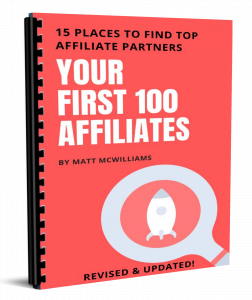 |
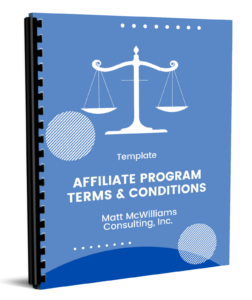 |
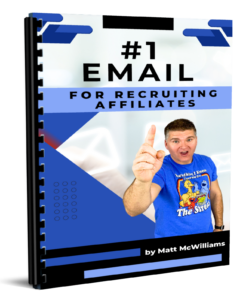 |
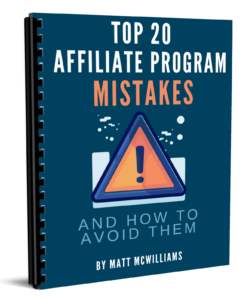 |
 |
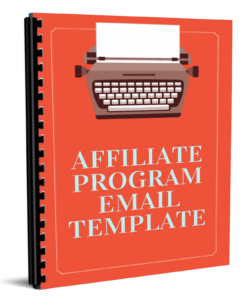 |
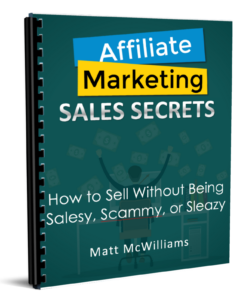 |
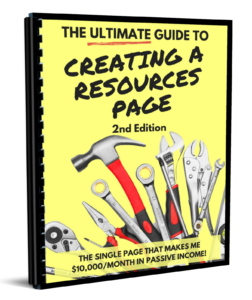 |
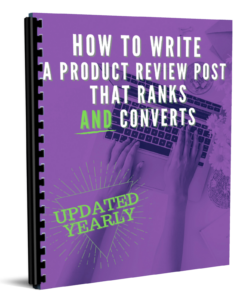 |
